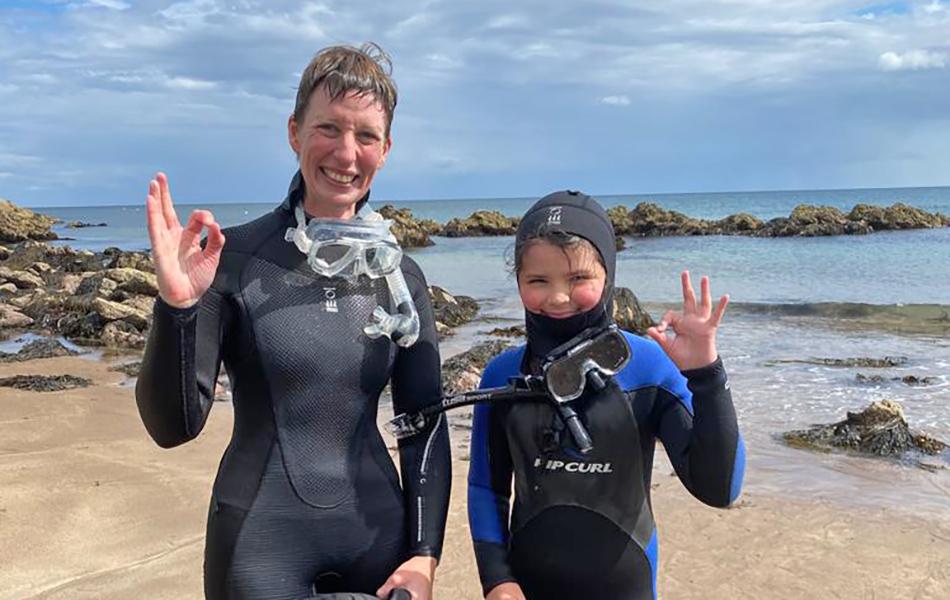
Andy Torbet remains an advocate of snorkelling through the winter, and here offers his up-to-date advice on cool tubing.
Almost six years ago I penned a column for SCUBA containing some tips and consideration to keep the avid snorkeller diving through winter. I thought it was about time to revisit the subject, as I’m sure BSAC has attracted many new members in that time. Indeed, those who have been in the club as long as I, and having partaken of large amounts of nitrogen, oxygen, helium and real ale in that time, may struggle to remember what I wrote half a decade ago. Or where they parked the car.
The main message is one of encouragement, in the face of some obvious disadvantages to winter snorkelling. The elephant (seal) in the room is that it can get decidedly cold, in and out of the water. Nothing tests one’s commitment than leaving icy waters to strip off in a blizzard. Trust me, I’ve done exactly that. However, there are also plenty of reasons when it’s better to hiber-not [once again, the English language winces – Editor] and get wet.
I’ve found snorkelling wreck sites can be more rewarding in winter. The kelp, which can smother the features of a ship or submarine in a thick layer of camouflage, dies back in winter and this means you can see more of the wreck itself. In fact, our shallow wrecks may be more visible for more reasons than kelp shedding its fronds. Algal blooms don’t happen in winter, dry, cold spells mean little to no run-off, and freshwater rivers and lakes can become crystal clear. Night dives become logistically easier as the nights draw in. No longer do we need to postpone our entry time to midnight to experience the alternative landscape and inhabitants that a night dive offers. It’s even possible, with an early rise, to fit a ‘night dive’ in before work and the late sunrise. Of course, there are some basic considerations for winter snorkelling that may be less pressing in the warmer months. The most obvious is the cold, both topside and sub-surface. If you don’t want to buy a thicker wetsuit you can always level up your existing suit with a shorty that’ll fit over the top.
Adding a hood and gloves, or a thicker variant, will help hugely as will the addition of some neoprene socks under your wetsuit boots. Make sure your pre-dive routine allows you to enter the water in a state of relative comfort; you’re unlikely to warm up once you’re in there. Changing into your wetsuit somewhere protected by the weather helps you stay warm as long as possible. Likewise, getting changed back into snug, comfy clothes out of the elements (even if it just means using a big, windproof robe) and having a flask of something hot to sip can be a big help. Of course, if you can make it to a seaside hostelry that serves warming beverages next to an open fire, that’s your post-dip gold standard.
As previously mentioned, sometimes the weather can play in our favour in winter, but often it can be windier and wetter. Don’t just look at the day of the dive but the preceding few days. Heavy rain can cause run-off and mess the visibility days after the event, as can strong winds in the wrong direction. These same rains can make rivers lethal, a much more serious issue than bad viz.
Please take time to consider your lighting resources. Even during a day dive, with the sun lower in the sky and the likelihood of cloud cover, a torch might become essential to get the most from your time in the water. Also consider illuminating yourself and your surface marker buoy with small lights. Night will commence much earlier and faster. You may commence your dive as a day-snorkel but exit the water as a night dive. “It was light when I went in” won’t be of consolation after you’ve been hit by a boat.
So, yes, there are challenges to winter snorkelling. But with some prep and motivation they can be overcome and endured. After all, if we didn’t relish a challenge, and couldn’t cope with imperfect conditions, we’d not be British Divers!
Article by Andy Torbet first published in SCUBA magazine, Issue 131 December 2022. Images in this online version have been substituted from the original images in SCUBA magazine due to usage rights.

 Author: Andy Torbet | Posted 21 Dec 2022
Author: Andy Torbet | Posted 21 Dec 2022



